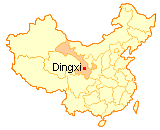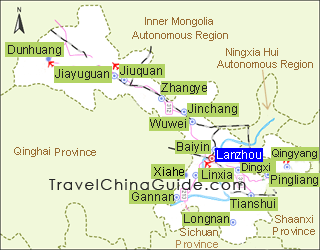Dingxi Travel Guide
Dingxi Facts
Chinese Name: 定西市 (dìng xī shì)
Population: 2,821,700
Area: 20,330 square kilometers (7,849 square miles)
Location: in the central Gansu Province, northwestern China
Administrative Division: 1 district (Anding); 6 counties (Tongwei, Lintao, Zhangxian, Minxian, Weiyuan, Longxi)
Area Code: 0932
Zip Code: 743000
GDP (2018): CNY 356.26 billion (USD 53.84 billion)
Famous Producing Area of Traditional Chinese Medicine
Dingxi City is located in central Gansu Province neighboring Lanzhou and Baiyin to the north, Pingliang and Tianshui to the east, Longnan to the south, Gannan and Linxia to the west. Dingxi, an important town on the ancient Silk Road, becomes a must pass of new Eurasian Continental Bridge. As the east gate of Lanzhou, it is only 98 kilometers (61 miles) away from there. With a long history of planting traditional Chinese medicine, Dingxi is one of the important producing areas of excellent traditional Chinese medicine. Besides that, potato is the first leading industry in Dingxi. Thus Dingxi has become one of the three major Chinese potato production areas.
Dingxi Attractions - Things to Do
The Dragon Palace of Li family is the only ancient architectural complex preserved in the west of Gansu Province which was the ancestral hall of Li clan.
How to get to Dingxi
1. It is only 98 kilometers (61 miles) from the capital city, Lanzhou. Longhai (Lanzhou-Lianyungang) Railway and the secondary line of Baoji-Lanzhou Railway pass through Dingxi and No.310, 312, 212, 316 national highways and other expressways radiating from Lanzhou all run across Dingxi. It makes the city definitely the east gate to the capital city of Gansu.
2. Dingxi Railway Station and the bus station are not far away from each other, both located in Jiaotong Lu of Anding District.
Weather
The northern region of Dingxi enjoys a middle temperate semi-arid climate and the south bears a warm temperate semi-humid climate. Strongly affected by its landform and the monsoons, the temperate is higher in the north than that in the south, while the rainfall is quite the opposite. The annual average temperature maintains around 5.6![]() C-7.6
C-7.6![]() C (42.1
C (42.1![]() F-45.7
F-45.7![]() F).
F).
![]() When to Go: Sandstorms are common in spring, and it is chilly in winter. Summer and autumn are the best times to visit.
When to Go: Sandstorms are common in spring, and it is chilly in winter. Summer and autumn are the best times to visit.

